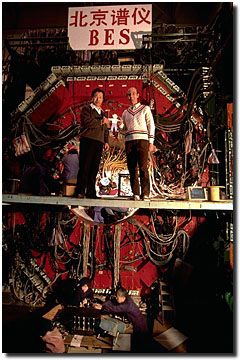 |
| Li Jin (left), the Chinese spokesman for the Beijing Spectrometer
from the Institute for High Energy Physics, poses with University of Texas-Dallas
physicist Joe Izen in front of the Beijing Spectrometer. The Internet has
broken down logistical barriers that in the past made it difficult for American
scientists to participate in the experiment. (Photograph by Adrian
Bradshaw)
| |
 |  here are many differences between China and
the United States -- language, culture, technology and economic structures
among them. But in one groundbreaking scientific collaboration, the Beijing
Spectrometer (BES) experiment, some of the distance has been bridged. here are many differences between China and
the United States -- language, culture, technology and economic structures
among them. But in one groundbreaking scientific collaboration, the Beijing
Spectrometer (BES) experiment, some of the distance has been bridged.
The project, teaming scientists from China's Institute of High Energy Physics
with physicists from eight U.S. universities and one national laboratory,
depends on the Internet to connect the far-flung laboratories and to help
the scientists bypass technical, cultural, and language hurdles.
The BES was initially launched in the late 1980s to develop profiles of
two elusive subatomic particles -- tau leptons and charmed quarks. "We
had some pretty serious misunderstandings and a big communication problem
in the years before the Internet link," says Joe Izen, a University
of Texas-Dallas physicist. Keeping track of which version of the jointly
developed software was most recent in both countries was a nightmare."Simply
maintaining contact was a problem, too. "We would speak by phone every
two weeks, but conference calls are difficult even when everyone is a native
speaker of English," Joe recalls. The lack of up-to-date data and the
communication barrier often left the American scientists feeling "more
like advisors than participants" in the experiments, he adds.
Today, Chinese and American physicists collaborating on BES can communicate
instantly via email and video conference with CU-SeeME using the first Internet
link set up specifically for them. And the World Wide Web, invented at CERN,
the European lab for high energy particle physics, has given the researchers
a way to easily view graphics and charts depicting experimental results.
"The Internet," says Joe, "came along at just the right time
for us." | |

